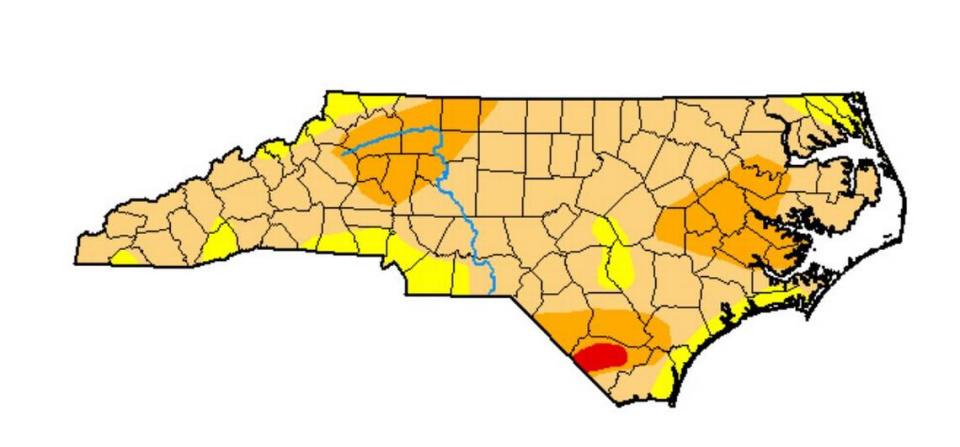NC drought worsens despite recent rain, with extreme conditions in more counties
Drought conditions have worsened across North Carolina, with one member of Congress calling for a U.S. Department of Agriculture disaster declaration to help farmers.
While the Triangle remains in moderate drought, nearly 20% of the state is in severe drought, according to a Thursday update from the N.C. Drought Management Advisory Council. That’s more than doubled since last week, with severe drought now in 22 counties.
In addition to the eastern part of the state from Wayne to Beaufort counties, severe drought exists in the northwestern corner from Caldwell to Rockingham counties and in the southeast from Robeson to western Pender counties.
“The state has quickly gone from normal in May to very, very dry. Rain during the last week slowed the rapid drying, but was not enough to improve areas,” Klaus Albertin, chair of the Drought Management Advisory Council, said in a statement.
The council recommends that areas in severe drought take steps to conserve water, including curbing nonessential uses like filling swimming pools, washing cars and using irrigation systems.
A swath of Columbus County is now in extreme drought, a first for this year. A weather station in Whiteville recorded 1.07 inches of rain over the past 30 days, the driest that 30-day period has been there in 24 years.
The extreme-drought designation requires more action. Once declared, water systems in the area must report their water conservation status to the N.C. Department of Environmental Quality’s Division of Water Resources.
Some areas like Harnett and Sampson counties saw localized rain that helped with drought conditions there over the past week. But the rain did not make a meaningful difference in soil moisture and groundwater, the drought advisory council warned.
“We need a lot more. I’m not going to say we need a tropical storm, but we do need some additional rain to help with the drought season,” Richard Rogers, the director of the Division of Water Resources, told the Environmental Management Commission on Thursday.
Some relief could be on the way for Eastern North Carolina, with forecasters predicting 1.5 to 4 inches of rainfall through Friday. But, Albertin warned,irreparable damage to crops may have already occurred.
Corn has been hit particularly hard, with the U.S. Department of Agriculture’s N.C. Field Office classifying 40% of the state’s crop classified as being in very poor condition and another 33% as poor condition. The state’s pastures are also suffering, with 9% in very poor condition and another 48% in poor condition.
Shawn Harding, the president of the N.C. Farm Bureau, said in an interview, “Corn was damaged beyond repair and so it’s done. Unfortunately, the only thing we can do is look to get some help.”

Disaster declaration for drought?
Earlier this week, U.S. Rep. Don Davis, a Snow Hill Democrat who represents North Carolina’s 1st Congressional District, called on U.S. Department of Agriculture Secretary Tom Vilsack to declare a disaster area for the district’s 19 counties.
“The current drought situation is reaching a critical point,” Davis wrote, describing visiting withered cornfields and seeing “parched tobacco plants.” Drought conditions impact not only farmers but the businesses that rely on them in rural communities, Davis added.
Eastern North Carolina isn’t the only part of the state to see agricultural impacts, with extension reports in Western North Carolina indicating that grass and pastures are growing slowly, meaning there will not be as much hay to harvest this year. That will impact what farmers have available to feed livestock over the winter.
“We absolutely hope that we can be looked at as an area that needs help,” Harding said.
A formal request for an agricultural disaster declaration must come from the governor’s office, an Indian Tribal Council representative or the Farm Service Agency’s state executive director.
The USDA does have a process that provides a virtually automatic disaster declaration if any part of the county is under the severe drought or worse for eight or more weeks during the growing season. The federal agency could also approve an emergency declaration, albeit more slowly, if a county loses 30% of at least one crop or if farmers aren’t able to secure financial assistance through other institutions.
It’s too early in the growing season to know the full extent of crop damage and loss, Andrea Ashby, a spokeswoman for the N.C. Department of Agriculture, wrote in an email. Knowing the percentage of that loss would be one of the ways to secure the slower disaster declaration.
“There is still a considerable amount of the growing season in front of farmers and the only way we will know the extent of damage and loss will be at harvest time. That means there is still a lot to sort out between now and the end of the season,” Ashby wrote.
This story was produced with financial support from the Hartfield Foundation and Green South Foundation, in partnership with Journalism Funding Partners, as part of an independent journalism fellowship program. The N&O maintains full editorial control of the work. If you would like to help support local journalism, please consider signing up for a digital subscription, which you can do here.


